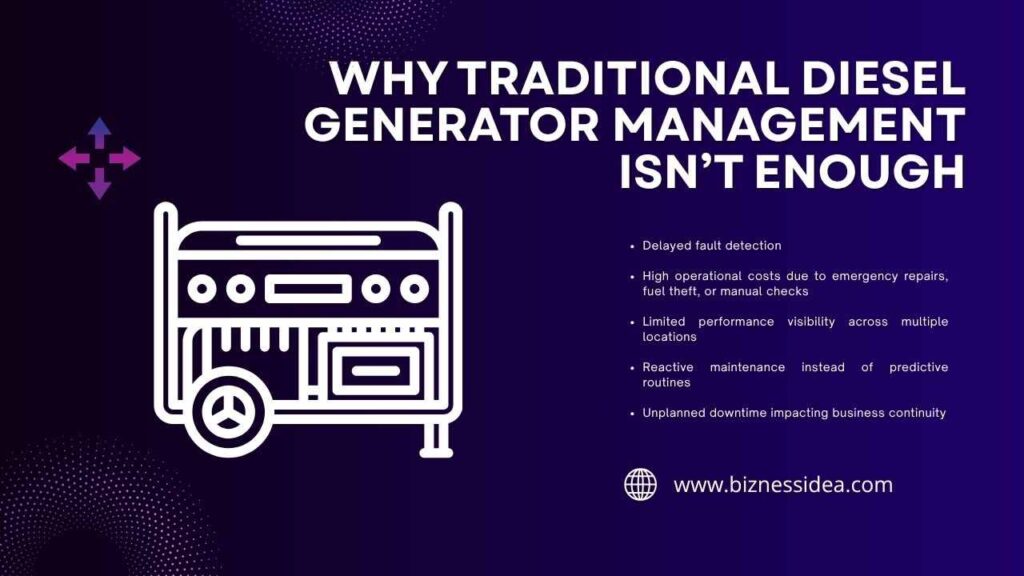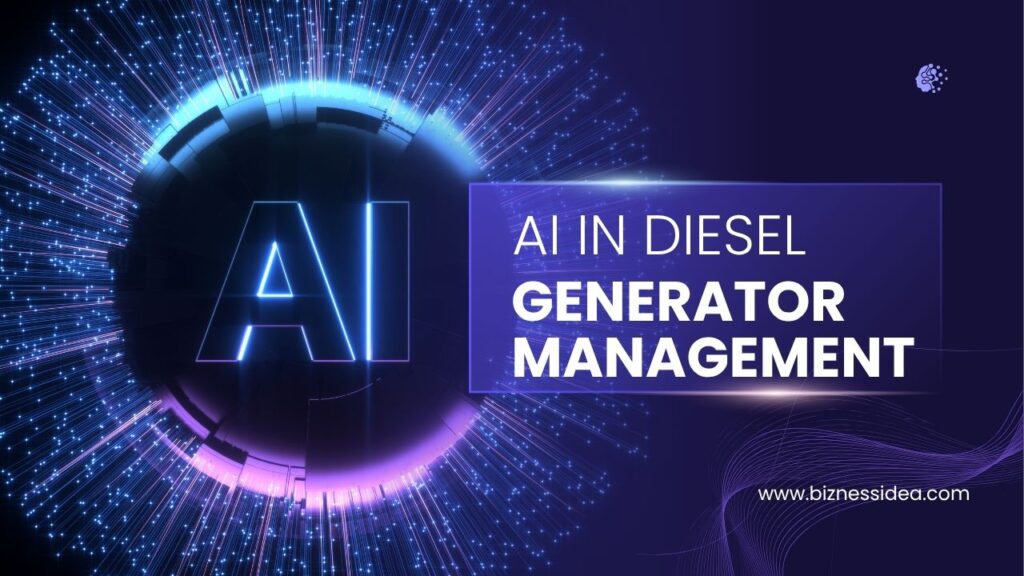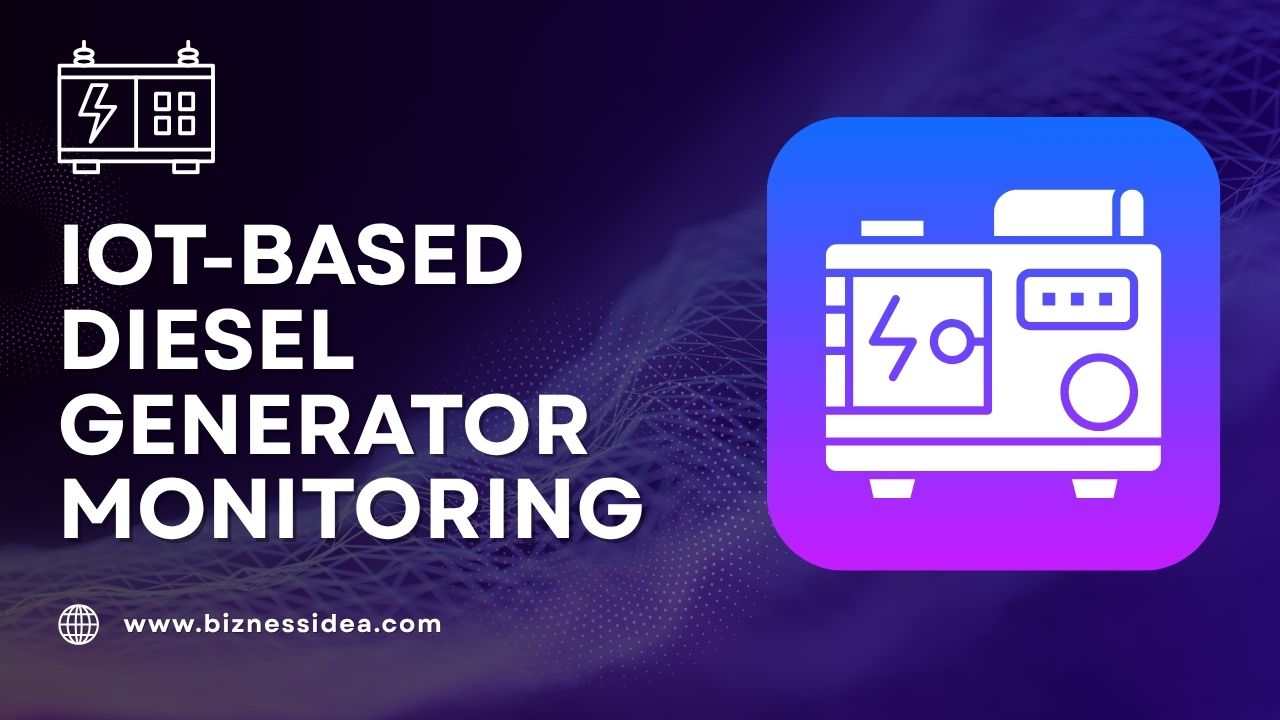Diesel generators power industries, hospitals, data centres, telecom infrastructure, and remote operations where uninterrupted electricity is critical. However, traditional supervision has depended on manual inspections, periodic maintenance checks, and reactive troubleshooting. This approach often leads to fuel inefficiency, unexpected breakdowns, safety risks, and operational downtime. Today, IoT-based diesel generator monitoring is redefining how businesses manage and supervise these critical assets. Instead of responding to faults after they occur, connected systems now enable real-time DG monitoring, remote diagnostics, and predictive maintenance. This shift is reshaping operational standards across industries that depend on backup and off-grid power.
Why Traditional Diesel Generator Management Isn’t Enough

Historically, technicians conducted physical site visits to review parameters like fuel level, temperature, voltage, and battery health. While this may have worked in small setups, it created serious challenges at scale:
- Delayed fault detection
- High operational costs due to emergency repairs, fuel theft, or manual checks
- Limited performance visibility across multiple locations
- Reactive maintenance instead of predictive routines
- Unplanned downtime impacting business continuity
As organisations expanded, it became clear that manual supervision cannot keep pace with modern diesel generator monitoring.
How IoT-based Diesel Generator Monitoring Enables Real-Time Visibility
IoT technology modernises generator monitoring by connecting sensors, controllers, and tracking devices to a centralised platform. These smart systems measure critical parameters such as:
- Fuel level and consumption rate
- Engine temperature
- Voltage and current output
- Lubricant pressure
- Battery performance
- Run hours and load status
- Vibration and noise anomalies
The collected data is sent through GSM, LTE, Wi-Fi, NB-IoT, or satellite networks to a cloud platform or control hub. Operators can access the data through a dashboard or mobile app without making site visits. This makes IoT-based diesel generator monitoring scalable, automated, and more efficient.
How AI Improves IoT-based Diesel Generator Monitoring and Reliability

While IoT captures data, AI interprets it to make intelligent decisions. Artificial intelligence analyzes real-time and historical data to detect anomalies, predict faults, and optimize performance.
Key AI-driven benefits include:
Predictive Maintenance
AI identifies unusual patterns that indicate potential failures in components like alternators, batteries, and injectors.
Fuel Monitoring & Efficiency
Algorithms detect abnormal fuel drops, leakage, or pilferage across locations.
Automated Alerts
Teams receive early warnings to prevent downtime and costly breakdowns.
Load Optimization
AI helps maintain ideal generator load conditions, reducing wear and emissions.
Performance Benchmarking
Data comparisons improve operational reliability across different sites or fleets.
Real-World Use Cases of AI & IoT-based Diesel Generator Monitoring
Industries are rapidly implementing smart monitoring due to its operational and financial benefits. Here are common applications:
1. Telecom Towers
In remote or low-power regions, IoT systems reduce theft, fuel waste, and breakdowns while AI predicts generator run-time needs.
2. Hospitals & Healthcare
Smart systems ensure backup generators operate reliably in life-critical environments.
3. Manufacturing & Industrial Facilities
Predictive maintenance reduces downtime and production delays.
4. Data Centers
IoT and AI prevent generator failure before it affects cooling systems or servers.
5. Remote Sites & Construction Locations
Connected monitoring eliminates manual inspections in isolated or high-risk environments.
Technology Stack Behind IoT-based Diesel Generator Monitoring
A typical smart monitoring ecosystem includes:
- Sensors and Hardware Modules – Installed directly on the DG to capture key metrics.
- Communication Networks – GSM, LTE, LoRaWAN, NB-IoT, Wi-Fi, or satellite-based data transfer.
- Cloud or On-Premise Platforms – Host dashboards, reports, alerts, and analytics.
- AI/ML Engines – Analyse data and generate predictions or early warnings.
Mobile and Web Interfaces – Enable remote access, command control, and notifications.
Benefits of IoT-based Diesel Generator Monitoring
Reduced Downtime
Predictive diagnostics and automatic alerts prevent unexpected shutdowns.
Real-Time Fuel Monitoring
Instant visibility into consumption, leakage, and theft.
Lower Maintenance Costs
Need-based servicing replaces scheduled manual checks.
Remote Accessibility
Multiple generator sites can be monitored from a single dashboard.
Extended Generator Life
Optimised usage minimises wear and tear.
Better Compliance & Reporting
Automated logs and analytics simplify audits and inspections.
AI’s Role in Predictive Reliability to Enhance IoT-based Diesel Generator Monitoring
What truly sets AI apart is its ability to learn and forecast potential failures before they happen. For example:
- Vibration anomalies can indicate motor or bearing issues
- Irregular fuel burn rates may suggest leakage
- Sudden engine temperature spikes can signal alternator problems
Instead of experiencing downtime, AI triggers timely service visits, protecting businesses from system failure.
The Future of AIoT in Diesel Generator Monitoring
The combination of AI and IoT is evolving into AIoT, enabling automated actions beyond monitoring. In the coming years, we can expect:
- Self-regulating load balancing
- Automated fuel ordering
- Integration with renewable energy systems
- Zero-touch maintenance workflows
- Carbon footprint tracking
- Edge AI for faster decision-making
Businesses adopting these technologies early will gain long-term resilience and competitive advantage.
Conclusion
IoT and AI are no longer optional upgrades—they are transforming how mission-critical diesel generators are monitored and maintained. Systems that once relied on periodic checks now operate with real-time intelligence and predictive insights. From improved uptime to fuel savings, IoT-based diesel generator monitoring is becoming standard across industries.
As organisations adopt scalable platforms and AI-powered analytics, the shift from reactive maintenance to smart, insight-driven efficiency is already underway.
FAQs
Q1. What is IoT-based diesel generator monitoring?
Ans. It uses connected sensors and devices to track generator performance in real time, enabling predictive maintenance, remote diagnostics, and optimised fuel usage.
Q2. How does IoT improve diesel generator management?
Ans. Start by defining goals, choosing platforms, setting content themes, and mapping posts in a template with captions, visuals, and CTAs.
Q3. What parameters are monitored in IoT based diesel generator systems?
Ans. Engine temperature, fuel levels, voltage, battery health, load, run hours, vibration, and noise are commonly tracked.
Q4. What are the benefits of implementing IoT for diesel generators?
Ans. Benefits include predictive maintenance, reduced operational costs, fuel monitoring, improved uptime, remote accessibility, and data-driven insights.
Q5. Can IoT-based monitoring prevent generator breakdowns?
Ans. Yes. By analysing real-time data and identifying early warning signs, IoT and AI systems anticipate failures and enable proactive intervention.













